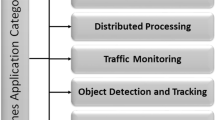Abstract
In this paper, we present a novel gait, forward head serpentine (FHS), for a two dimensional snake robot. The advantage of this new gait is that the head link remains in the forward direction during motion. This feature significantly improves snake robot potential applications. Genetic Algorithm (GA) is used to find FHS gait parameters. Relationship between FHS gait parameters and friction coefficients of the ground are developed. Next, robot speed is considered in the optimization. A fitness function covering robot speed and head link angular changes is defined. A general sinusoidal wave form is applied for each joint. GA is used to find gait parameters resulting in maximum speed while head link angular changes remain in an acceptable range. Optimal gait parameters are also calculated for different friction coefficients and relationships between them are developed. Experiments are also performed using a 5-link snake robot. It is shown that experimental and theoretical results closely agree.
Similar content being viewed by others
References
Burdick, J., Radford, J., & Chirikjian, G. (1995). A ‘sidewinding’ locomotion gait for hyper-redundant robots. Advanced Robotics, 9(3), 195–216.
Chirikjian, G. S., & Burdick, J. W. (1993). Design and experiments with a 30 DOF robot. In Proceedings of 1993 IEEE international conference on robotics and automation (pp. 113–119).
Chirikjian, G., & Burdick, J. (1995). The kinematics of hyper-redundant robot locomotion. IEEE Transaction on Robotics and Automation, 11(6), 781–793.
Choi, H. R., & Ryew, S. M. (2002). Robotic system with active steering capability for internal inspection of urban gas pipelines. Mechatronics, 12(2002), 713–736.
Crespi, A., Badertscher, A., Guignard, A., & Ijspeert, A. J. (2005). Amphibot I: an amphibious snake-like robot. Robotics and Autonomous Systems, 50, 163–175.
Date, H., Hoshi, Y., & Sampei, M. (2000). Locomotion control of a snake-like robot based on dynamic manipulability. In Proceedings of the 2000 IEEE/RSJ international conference on intelligent robotics and systems (pp. 2236–2241).
Date, H., Hoshi, Y., Sampei, M., & Nakaura, S. (2001). Locomotion control of a snake-like robot with constraint force attenuation. In Proceedings of the American control conference (pp. 113–118).
Dowling, K. (1997). Limbless locomotion: learning to crawl with a snake robot. Ph.D. Thesis, Robotics Institute, Carnegie Mellon University, Pittsburgh, PA, December 1997. http://www.societyofrobots.com/robottheory/limbless_locomotion.pdf. Accessed 25 July 2008.
Endo, G., Togawa, K., & Hirose, S. (1999). Study on self-contained and terrain adaptive active cord mechanism. In Proceedings of the 1999 IEEE/RSJ international conference on intelligent robots and systems (pp. 1399–1405).
Fukushima, E. F., Hirose, S., & Hayashi, T. (1998). Basic manipulation considerations for the articulated body mobile robot. In Proceedings of the 1998 IEEE/RSJ international conference on intelligent robots and systems (pp. 386–393).
Hirose, S. (1993). Biologically inspired robots (snake-like locomotor and manipulator). London: Oxford University Press.
Hirose, S., & Morishima, A. (1990). Design and control of a mobile robot with an articulated body. The International Journal of Robotics Research, 9(2), 99–114.
Ijspeert, A. J. (2001). A connectionist central pattern generator for the aquatic and terrestrial gaits of a simulated salamander. Biological Cybernetics, 85(5), 331–348.
Inoue, K., Sumi, T., & Ma, S. (2007). CPG-based control of a simulated snake-like robot adaptable to changing ground friction. In Proceedings of IEEE/RSJ international conference on intelligent robots and systems (IROS 2007) (pp. 1957–1962).
Klaassen, B., & Paap, K. L. (1999). GMD-SNAKE2: a snake-like robot driven by wheels and a method for motion control. In Proceedings of 1999 IEEE international conference on robotics and automation (ICRA 1999) (pp. 3014–3019).
Ma, S., Araya, H., & Li, L. (2002). Development of a creeping snakerobot. International Journal of Robotics and Automation, 17(4), 146–153.
Matsuno, F., & Sato, H. (2005). Trajectory tracking control of snake robots based on dynamic model. In Proceedings of IEEE international conference on robotics and automation.
McIsaac, K. A., & Ostrowski, J. P. (2000). A geometric approach to gait generation for the anguilliform robot. In Proceedings of the international conference on intelligent robots and systems (IROS 2000) (pp. 2230–2235).
Prautsch, P., & Mita, T. (1999). Control and analysis of the gait of snake robots. In Proceedings of the 1999 IEEE international conference on control applications (pp. 502–507).
Prautsch, P., Mita, T., & Iwasaki, T. (2000). Analysis and control of a gait of snake robot. Transactions of the Institute of Electrical Engineers of Japan, 120-D(3), 372–381.
Saito, M., Fukaya, M., & Iwasaki, T. (2002). Serpentine locomotion with robotic snakes. IEEE Control Systems Magazine, 22(2002), 64–81.
Tanev, I., Ray, T., & Buller, A. (2005). Automated evolutionary design, robustness, and adaptation of sidewinding locomotion of a simulated snake-like robot. IEEE Transactions on Robotics, 21(4), 632–645.
Umetani, Y., & Hirose, S. (1976). Biomechanical study of active cord mechanism with tactile sensors. In Proceedings of the 6th international symposium on industrial robots (c1-1–c1-10).
Ute, J., & Ono, K. (2002). Fast and efficient locomotion of a snake robot based on self-excitation principle. In Proceedings of the 7th international workshop on advanced motion control (pp. 532–539).
Author information
Authors and Affiliations
Corresponding author
Rights and permissions
About this article
Cite this article
Hasanzadeh, S., Tootoonchi, A.A. Ground adaptive and optimized locomotion of snake robot moving with a novel gait. Auton Robot 28, 457–470 (2010). https://doi.org/10.1007/s10514-010-9179-y
Received:
Accepted:
Published:
Issue Date:
DOI: https://doi.org/10.1007/s10514-010-9179-y




